|
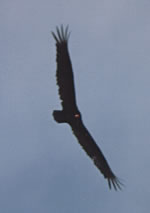 The
birds descend from the darkening sky as rain slips across
the redrock cliff. Strong winds stir a thick porridge of dust
and debris that chokes the valley. Trees sway like festivarians
to the windy rhythm, and thick, cold drops of rain pound the
pavement with a staccato beat. The flock of birds finds shelter
amongst the tree’s thick branches, waiting out the weather. The
birds descend from the darkening sky as rain slips across
the redrock cliff. Strong winds stir a thick porridge of dust
and debris that chokes the valley. Trees sway like festivarians
to the windy rhythm, and thick, cold drops of rain pound the
pavement with a staccato beat. The flock of birds finds shelter
amongst the tree’s thick branches, waiting out the weather.
These fronts sweep across the landscape here, punctuating
weeks of pleasant temperatures with short-lived winds and
rain. Nice weather if you’re a duck, but for the thirty
or so turkey vultures perched in the large cottonwoods, these
storms can raise hell with your migration schedule.
Ranging from the tip of Cape Horn to Canada, vultures are
migratory in these parts. They do not stick around during
the winter, but choose to head south. Though they occur in
summer, a handful of nesting records for southeastern Utah
exist. Though vultures are known to fly through inclement
weather, these birds decide to layover and take in the sights.
Or smells, as may be the case.
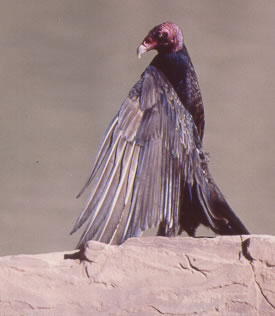 Related to hawks and eagles, vultures share a common trait
of excellent vision with their predatory relatives. Some ornithologists
group New World vultures with storks and flamingos, because
their weak feet are used more for perching than for grasping
prey. Where the vulture diverges from their hooked-beak cousins,
is in their ability to locate prey by smell.
Related to hawks and eagles, vultures share a common trait
of excellent vision with their predatory relatives. Some ornithologists
group New World vultures with storks and flamingos, because
their weak feet are used more for perching than for grasping
prey. Where the vulture diverges from their hooked-beak cousins,
is in their ability to locate prey by smell.
To a vulture, there is nothing finer than the aroma of a rotting
carcass. Their genus name, Carthartes, means “cleanser”,
a reflection upon their behavioral trait of never passing
up a good meal of road kill. Of course, these birds descend
en masse to a banquet of deer or elk; often their communal
soaring is a signal to others, like ravens, eagles and coyotes,
to join in on the banquet. This trait encouraged the Cherokee
Nation to call these birds “Peace Eagles.”
Often maligned for consuming putrid flesh, where would we
be without these scavengers? The carcasses would be piling
up. Carrion is not the only food that vultures eat. In a recent
study of vulture pellets, biologists found that vegetation
comprised over 50% of the vulture’s diet. With a digestive
system that can process and kill viruses and bacteria, the
vulture is the picture-perfect garbage disposal unit. Worries
about the vulture’s fecal material containing these
pathogens are unfounded.
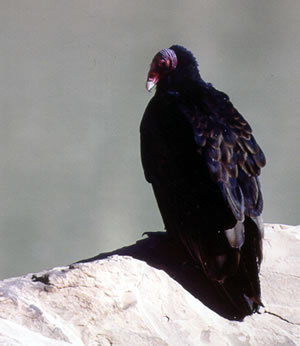 Morning catches these bald-headed birds roosting in large
cottonwoods or along cliff ledges. Holding their wings out
to the sides, the birds absorb some vitamin D from the sun,
plus catch some warming rays. They spend a considerable amount
of time preening and bathing each day – you would too
if you spent time with your head inside of a dead deer’s
body cavity.
Morning catches these bald-headed birds roosting in large
cottonwoods or along cliff ledges. Holding their wings out
to the sides, the birds absorb some vitamin D from the sun,
plus catch some warming rays. They spend a considerable amount
of time preening and bathing each day – you would too
if you spent time with your head inside of a dead deer’s
body cavity.
Late in the afternoon the vultures return to these roosts.
Swirling about in an aerial kettle, unlike the organized V’s
of geese skeins, their six-foot wingspans collapse as the
birds descend back into the trees.
If I was a member of The Turkey Vulture Society – don’t
laugh, such an organization exists, perhaps I would spend
more time at these roosts, plotting the positioning of each
bird. I’d get to know them as individuals, not as just
another pretty face in the crowd. Maybe one sports a leg band,
a USFWS identification, which would shed light on the bearer.
Perhaps I’d find that these birds select the same roost
on the same day each year until they are ready to resume their
northward migration.
I can, and do, appreciate the position these scavengers hold.
I enjoy their aerial acrobatics, their playful flights and
effortless soaring. I wish them well on their northward migration,
keeping in mind that I could always attend the 10th annual
Turkey Vulture Festival in California this September. And
you thought Utah was weird!
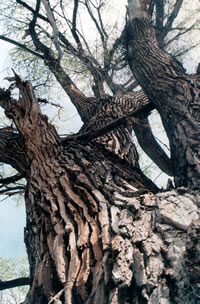 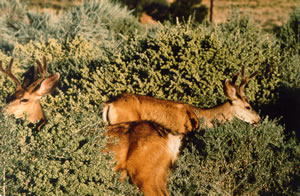
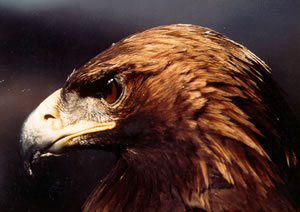
|